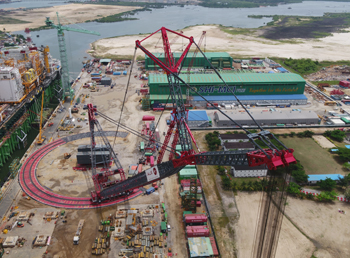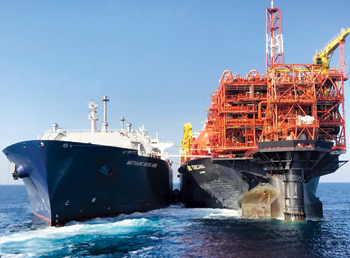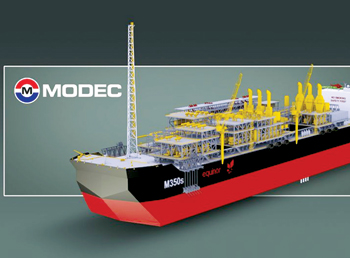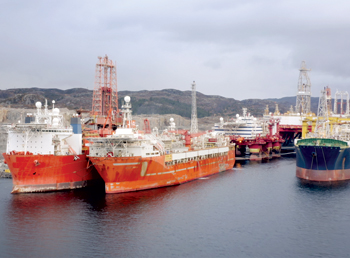
 The P-74 project in Brazil ... making use of Mammoet’s heavy lift cranes a highly effective solution
The P-74 project in Brazil ... making use of Mammoet’s heavy lift cranes a highly effective solution
With expectations that the majority of upcoming FPSO projects will be for the South American and African markets, Mammoet explores how ports and yards in these regions can ensure they are in the best position to serve this growing demand
A strong pipeline of floating production storage and offloading (FPSO) projects is anticipated in the coming decade, with around 110 already at the planning stage. These new assets will be focused on pushing the limits of processing capability, and in doing so they are likely to move away from lower capacity refurbished vessels in favour of purpose-built designs.
Although only a selection of currently planned FPSO projects will proceed to production, it’s likely there will be enough to keep specialised shipyards fully booked for years to come. This will mean that the integration work for many of these projects will not be carried out at an established facility that has the required expertise, lifting and transportation capacity readily available.
This is likely to be compounded further by local content requirements, another reason why projects need to use facilities local to the awarding country, rather than choosing from the broader selection of expertise and equipment available globally. Although at first glance this is good news for smaller local ports and yards, the scale and demands of FPSO projects means that many may struggle to meet the requirements to be considered by EPCs.
 |
For example, the shallower water depths at smaller ports mean that floating cranes must be used to integrate heavier modules in open water, rather than directly at the quayside.
Storage space must also be found for incoming modules that can be tens of thousands of cubic meters. At smaller yards, these modules must be moved to and from storage by auxiliary equipment that must be hired and left on standby at cost, for example, SPMTs, trailers, forklifts and small cranes.
The sheer weight of FPSO modules is also a significant issue for smaller yards and ports. Seeking greater efficiencies, these have grown to regularly exceed 3,000 tonnes, and can be well over 5,000 tonnes for FLNG projects.
Very few ports in the world have the infrastructure to lift these kinds of objects. In addition, the land at many smaller ports will not withstand the required ground bearing pressures – above 25 tonnes/sq m – to make these lifts a reality – especially close to the quay wall, where it is weakest.
So, the bottleneck in suitable space and capacity at smaller yards could force EPCs to consider using a higher number of smaller, lighter modules to make projects feasible. This would be sub-optimal as it would result in less efficient FPSO vessels, increasing the number of moves required to build them, the number of connections, the number of commissioning tests and, therefore, the overall costs involved.
LOWER AVAILABILITY
The situation is complicated further by greater competition from outside the oil and gas industry for both locations and equipment, due to the huge growth in offshore wind projects as the world moves to more renewable energy sources. There are over 275 offshore wind projects planned for the next five years alone, with roughly 10 per cent of these being floating foundation projects as opposed to conventional fixed bottom turbines.
This means demand for space in ports will only increase in the short term, with floating offshore wind projects in particular needing very similar lifting and transport equipment to FPSO integrations.
All of which means that yards will have to work with a smaller toolbox during projects for the oil and gas sector.
DEMAND FOR EXPERTISE
Additionally, the skilled labour needed for FPSO integrations will also be more difficult to find. In some cases, this could mean up to 1,500 people working at height, adding cost and safety risks for both the yard owner and the EPC.
But the concentration of FPSO projects in South America and Africa also means that a high volume of skilled labour will need to be sourced in regions without a strong track record in this type of work.
Finding solutions to these challenges will benefit organisations across the supply chain; ports and yards will be able to compete for work they may not otherwise consider, whilst EPCs will benefit from greater choice in how to meet local content requirements and fulfil their projects.
Some of the solutions that are key to getting more facilities ready for FPSO projects, include the following:
• Increasing lift capacity: Addressing the bottleneck of lifting capacity at local yards and ports will open up options for EPCs, allowing more locations to handle the largest possible module sizes and, therefore, the most efficient fabrication and integration methodologies.
But this improvement in infrastructure must be done in a way that minimises capital expenditure, making the use of Mammoet’s heavy lift cranes a highly effective solution. These giant lifting machines offer a number of key advantages for FPSO projects.
The capacity to make lifts well in excess of 1,000 tonnes means that modules can be lifted from their point of fabrication, or very close to it. This means they can be built, partially integrated and tested at ground level. This helps to minimise not only working at height costs and safety risks, but also transportation costs.
This was a critical factor for the Egina FPSO project in Nigeria, as it enabled Total to satisfy local content requirements by integrating modules locally to the oil field. In total, six topside modules were built and integrated in Nigeria, with a high proportion of project hours worked in the country by 1,700 people there.
In addition to lifting power, the long outreach of heavy lift cranes also offers important benefits and flexibility, including multiple lifts from a single crane position. The safety and scale of lifts can be increased by exerting ground pressure away from the weaker quay edge.
This proved useful for the P-74 project in Brazil, where Mammoet’s SK350 crane offered an outreach of up to 81 m to work around ground conditions on site without compromising module sizes.
This can be a notable advantage, as ports will not need to budget for as much auxiliary transport equipment, as projects can be completed using equipment already owned by the yard.
• Low ground bearing pressures: Lifting heavy loads exerts high pressure on quaysides, which can rule out the construction of larger modules and certain types of integration work, such as skidding. In many cases, reinforcing the quayside is too expensive to consider so other solutions must be found.
The use of a crane with long outreach as detailed above is one solution. However, with pressures of between 20 and 28 tonnes/sq m typical for the lifting of heavy modules, further work is sometimes needed to make the most of the land available, especially at smaller yards, which may have the required quay space but not suitable areas to load-in, marshal and store modules ready for integration.
Mammoet’s Enviro-Mat is useful here, as it allows land to be developed to withstand higher pressures. Added to a mixture of site soil and cement, Enviro-Mat produces a surface that can easily achieve ground bearing pressures of 30 tonnes/sq m and as high as 50 tonnes/sq m. Importantly, whilst it can be used as a permanent surface, it can also be easily crushed and returned to the soil with no environmental impact.
• Opening new locations: Mammoet’s SK6000 crane has been designed specifically to meet the demands of growing FPSO module sizes. Despite its huge 6,000-tonne lift capacity, it is suitable for use at large and small ports alike, given that its design prioritises efficient use of space and minimises the ground bearing pressures exerted. These are typically 9-12 tonnes/sq m when idle and 20-28 tonnes/sq m when lifting, meaning the SK6000 has the power to bring some of the world’s largest projects to unexpected locations.
The combination of its lift capacity and outreach of 144 m gives maximum flexibility in methodology, so even large-scale modules can be lifted with one piece of equipment and from just one location. This includes flare towers of up to 1,500 tonnes and 150 m, meaning a single crane could integrate the entire vessel, if needed.
• Optimising existing facilities and expertise: In addition to ensuring the right lifting equipment and ground bearing pressures, shipyards will also need to consider a range of other upgrades and optimisations to be able to accommodate the larger FPSO projects being planned.
Specialised slinging arrangements can maximise the lift capacity possible from cranes at port, utilising carbon fibre rope slings to ensure effort is expended lifting the load rather than the rope. Additionally, adjustable rigging systems that shift the centre of gravity during each lift help to cut down on reconfiguration of the crane, in turn saving time and money during the course of a project.
• Alternate integration methods: As modules get larger, Mammoet is also seeing increasing demand for the movement of some truly massive loads. This has included a number of record-breaking projects, such as the 47,830-tonne load-out of the Arkutun Dagi topside in Korea, the 40-m jack-up of the 13,800-tonne Malikai topside in Malaysia and the 24,000-tonne load-in of Shell’s Brent Delta topside in the UK.
Of course, this technology can be put to work during the integration of FPSO and FLNG vessels, under the right conditions. There’s no better example of this than the work with Saipem for the Jangkrik project.
Regions such as South America, Africa and the Middle East stand to benefit from a highly productive upcoming decade. In turn, EPCs will gain a more diverse marketplace to find the best outcome for their projects.





















































































